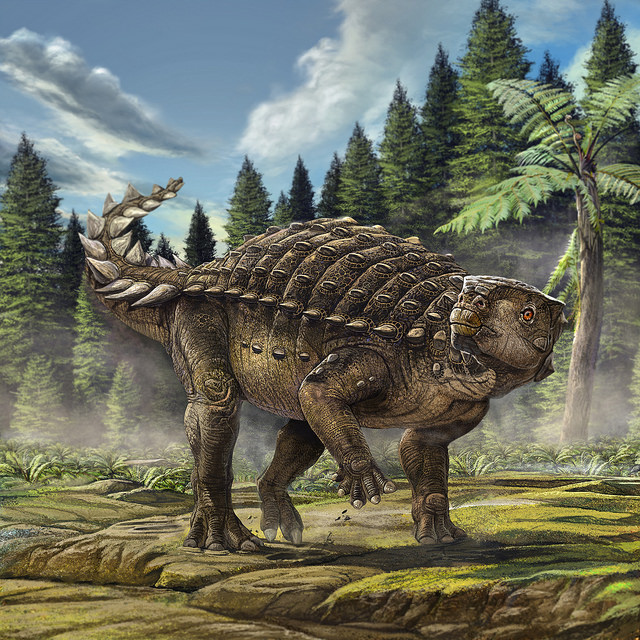Canadian and U.S. paleontologists have announced the discovery of a new genus and species of ankylosaurid dinosaur, Ziapelta sanjuanensis.

Life restoration of Ziapelta sanjuanensis. Image credit: © Sydney Mohr.
Ankylosauridae (ankylosaurs, ankylosaurids) is a family of plant-eating dinosaurs with armored plates on their back.
Ankylosaurs lived in what is now western North America, Europe and East Asia, between 122 and 66 million years ago.

They were not only armored but were also heavily armed – they often had shoulder spikes and large bony clubs at the end of their tails.
The newly-discovered ankylosaur, named Ziapelta sanjuanensis, roamed what is today New Mexico during the so-called Kirtlandian land-vertebrate faunal age, 74.8 to 72.8 million years ago.
Its fossilized skull and bones were uncovered from the Kirtland Formation at Hunter Wash, San Juan Basin, in northwestern New Mexico in 2011.

Complete skull of Ziapelta sanjuanensis; abbreviations: asca – anterior supraorbital caputegulum; bas – basioccipital; ch – choana; fm – foramen magnum; j – jugal; laca – lacrimal caputegulum; loca – loreal caputegulum; ltf – laterotemporal fenestra; mnca – median nasal caputegulum; nar – external naris; oc – occipital condyle; orb – orbit; pal – palatine; par – parietal; parocc – paroccipital process; pmx – premaxilla; psca – posterior supraorbital caputegulum; pt – pterygoid; q – quadrate; qj – quadratojugal; qjh – quadratojugal horn; snca – supranarial caputegulum; socc – supraoccipital; sqh – squamosal horn; tr – tooth row; v – vomer. Image credit: Arbour VM et al.

An analysis of the fossils shows that Ziapelta sanjuanensis stands out from other ankylosaurs because of unusually tall spikes on the cervical half ring, a structure like a yoke of bone sitting over the neck. The skull also differentiates it from other known ankylosaurs.
“The horns on the back of the skull are thick and curve downwards, and the snout has a mixture of flat and bumpy scales – an unusual feature for an ankylosaurid. There’s also a distinctive large triangular scale on the snout, where many other ankylosaurids have a hexagonal scale,” explained Dr Victoria Arbour from the University of Alberta, the lead author of the paper published in the journal PLoS ONE.
“Ziapelta sanjuanensis also shares several features with northern North American ankylosaurids – Ankylosaurus, Anodontosaurus, Euoplocephalus, and Scolosaurus.”
Source: sci.news








